- Home
- Rudy Rucker
As Above, So Below Page 4
As Above, So Below Read online
Page 4
For the next few days they spent the mornings in Giulio Clovio’s studio and the afternoons looking around Rome. In the evenings they’d dine all together and, for now, de Vos was staying fairly sober. Francesca’s behavior was unpredictable; sometimes she looked at them as if they were nothing but statuary, other times she was all winks and smiles. Once she threw a fava bean at de Vos’s head. But de Vos kept his distance; he’d switched his romantic aspirations to a young woman who sold flowers in a nearby market.
A steady stream of patrons and fellow artists came in and out of Clovio’s studio, and on the very first day, one of the patrons showed an interest in commissioning a genuine Flemish landscape painting by the two young artists. He was a conservatively dressed merchant with an eye for a bargain. He used the Italian word for “Flemish,” which was Fiammingo. The picture was to be called Landscape with Christ Appearing to the Apostles at the Sea of Tiberias. Though Bruegel would have liked to base his landscape upon his Alpine sketches and memories, the patron was very definite that he wanted a landscape “in the style of Patinir,” that is, a landscape of fantastic, tortured rocks shaped like nothing found in nature.
How dull, thought Bruegel, why did I bother to hike through the Alps? Once again it’s to be a painting of a painting. He confided some of his thoughts to Clovio and de Vos. But de Vos was no longer sympathetic—perhaps he remembered his choking after all—and the old painter shrugged off Bruegel’s protests.
“You don’t like the job, so what?” said Clovio. “You’ve got a customer. You sell the picture and then you paint another one. Maybe the next one is the way you like.”
“I could waste my life that way,” said Bruegel. “Waiting to begin.”
“Don’t give yourself airs, Peter,” put in de Vos. “If you can’t paint the landscape, I will.”
“Don’t you two spongers get wise,” said Clovio, growing sterner. “You’ll do this job for your rent, exactly as I say. Landscape by Bruegel, Christ and Apostles by de Vos.” And that was that.
Clovio gave Bruegel a seasoned oak panel to paint his landscape on, which was something of a treat. And, just so that de Vos wasn’t idle while waiting for his chance to add Jesus, Clovio put him to work shaping and polishing ivory disks for miniatures. The disks were cut from an actual pair of elephant tusks that lay on Clovio’s studio floor. When the master wasn’t around, Giampietrino liked to hoist one tusk beneath each arm and race around the room being an elephant.
Eager to impress Master Clovio with his skill as a Flemish artist, Bruegel worked at building his picture up by the Van Eyck “egg-oil method” which Master Coecke had taught him.
Van Eyck’s innovation for Flemish painting had been to use both egg and oil. In general, one prepared paint by mixing powdered pigments with a liquid; the Van Eyck trick was to mix one batch of paints with egg yolk, and to mix a separate batch with oil. The virtue of the egg-based paint, also known as egg tempera, was that it dried as rapidly as watercolor; in addition, egg temperas were good for drawing an accurate line. Oil-based paint, on the other hand, had great transparency and luminosity, and was ideal for putting a colored glaze over a previously flat area. Oil paint also had the virtue that it was easy to blend different hues of the slow-drying oils together, creating effects that could only be achieved with egg tempera by laborious crosshatching. Since Van Eyck, it had become customary for a Flemish master to use both. You started by making a neutral-colored egg tempera underpainting, glazed the underpainting with oil colors, added additional details in egg, laid on more oil colors, and so on. Bruegel knew all about it—or so he thought.
Bruegel gessoed his panel, carefully outlined his landscape upon it, and used shades of ocher mixed with egg yolk to flesh the drawing out into a fully modeled monochrome underpainting, brightening the highlights with white lead. The egg-tempera work dried to a fine hardness each afternoon, and before long he began layering on colored glazes of dilute oil paints, modeling the fantastic contours of the imaginary rocks.
The danger with the mixed method was that one could easily lose control of the technique, particularly when working with new materials for the first time. Clovio’s brushes, pigments, and oils were unlike the ones Bruegel was used to, and the eggs that Clovio’s cook gave Bruegel were rather lacking in freshness. Things didn’t go all that well. The painting was oily and smeared in spots, dry and dull colored in others. And it was taking up all of Bruegel’s time. Here he’d come to Rome to expand his horizons, and he was pissing away the precious sunny days on a picture doomed by its very conception to be a failure. And making a remarkably poor job of it, at that.
Meanwhile de Vos was getting impatient to put his figures on, as he was tired of endlessly polishing Clovio’s ivory blanks. He began nagging and rushing Bruegel, which made the picture go even worse. Noticing the tension, Clovio gave de Vos something else to do: he got him to start engraving designs onto the fancy bronze hinges that Clovio used on the little rosewood boxes that he put his finished miniatures in.
Nearly two weeks went by, and then Clovio’s miniatures were done and Cardinal Farnese showed up at the studio with a retinue of three lesser ecclesiastics, all of them dressed in fine silks, the Cardinal of course in red. He was a corpulent man with a face like a roast leg of mutton—quite brown and shiny, with lips that were crisp dark ridges of fat. He talked volubly, endlessly, in Italian. He showed every evidence of satisfaction with Clovio’s three miniatures of Julius III. Clovio nestled each of them into its velvet-lined, bronze-hinged rosewood case and accepted his pay. Still the Cardinal continued to talk.
Bruegel couldn’t tell whether or not Clovio had remembered to mention the Sistine Chapel, so he spoke up in his halting Latin to ask the Cardinal if he and de Vos could see it. Cardinal Farnese replied that, as it happened, he himself was to celebrate a private afternoon requiem mass in the Sistine Chapel this very day; the mass was being said for the soul of a very dear friend of the Pope’s. It would be no trouble at all for him to arrange admission for the foreign artists—“you little Oltramontani” as he addressed them, meaning “People from Beyond the Mountains”—provided that they could make a donation to his charity fund. The figure he named was surprisingly high.
“Too much,” said de Vos in Flemish. “Forget it, Peter.”
“Hush,” snapped Bruegel. It was impossible that this opportunity might be snatched away. He looked imploringly at Clovio, but the older painter seemed unmoved. “I’ll paint you a miniature,” he told Clovio. “I’ll paint it my way and you’ll love it. Please pay for us.” Clovio sighed, shook his head, and opened his freshly filled purse.
So Bruegel and de Vos attached themselves to the Cardinal’s party, who were riding back to the Vatican in two elegant open carriages. Clovio himself declined to accompany them. “I’ve seen it,” he said. “I prefer miniatures.”
As for de Vos, even though he was paying nothing himself, he was angry about the deal, and, as now became more and more evident, he was deeply uneasy about seeing Michelangelo’s work at all. De Vos seemed to be afraid that somehow the sight of these masterpieces would emasculate him as an artist. All the way to the Vatican, he was muttering angry Flemish sayings about the degeneracy of the Italian Church.
Their carriage rattled across the Tiber and pulled up before the partly finished St. Peter’s Basilica, which was covered in scaffolding and surrounded by great piles of marble. In the little spare time that he’d had in Rome, Bruegel hadn’t made it here yet. St. Peter’s and the Vatican, the very center of the world. They’d been building the Basilica for almost fifty years now; indeed the sale of papal indulgences had begun as a way to raise money for this, the largest church in history.
Beggars crowded around them as they dismounted. One of the Cardinal’s assistants cleared the way. He was a hard-looking young priest with a big jaw and a black cane. Bruegel had wondered why such a sturdy fellow needed a cane, but now he saw the cane spring into action; the priest slashed away at the beggars as if he were beatin
g rugs—though without managing to land a solid blow. There was a jut to the priest’s jaw and mocking agility to the beggars’ motions that Bruegel would have loved to draw. What a waste it was to be spending his days painting fake rocks.
Beyond the beggars were crowds of peddlers hawking relics, medals, and long printed prayers that were said only to work if one read them exactly word for word. A group of nuns sat behind a long table filled with painted plaster statues of the Virgin, St. Christopher, St. Barbara, St. Hipolytus, and St. George, with each statue’s face wearing the same blank simper. Their deadening uniformity put Bruegel in mind of the innumerable Italianate religious paintings he’d seen. Why did people want to see the same thing over and over and over?
A sleek priest offered him a fresh-printed indulgence, good for one hundred years off from the time that was owed to Purgatory as a residual “temporal debt” even after a sin was forgiven. A curtained confession booth was set up nearby, with a second priest prepared to calculate your current temporal debt. The booth resembled an outhouse. It was a melancholy sight to see such japery in full swing. And only last year Julius III had made proclamations about reforming the Church.
Past St. Peter’s and before entering the buildings of the Vatican Palace proper, they paused by an elegantly tiled villa where the Cardinal had his private apartments. Using a great iron key, the Cardinal unlocked a gate and the little party entered the building’s enclosed courtyard. A trio of voluptuous women appeared on the second floor balcony, calling lewdly down to the Cardinal. The Cardinal sent Clovio’s three boxed paintings upstairs with an assistant, and then his three mistresses began blowing kisses down to him. Actually, it was more than kisses, they were gesturing to him with their tongues, yes, their full-lipped mouths were wide open and their fat tongues licked about. The plump trulls tried to outdo each other in their bawdy display of licentiousness: cooing, giggling, and showing off their breasts and legs. The Cardinal seemed tempted to lug his carcass up to join them, but he still had his requiem mass to do, so it was onward to the Sistine Chapel.
Seeing the three courtesans had thrown de Vos into a frenzy of outrage and lust. “It’s said that the degenerate Emperor Nero had his gardens here,” he said in a quiet, angry tone. “Things haven’t changed a bit.” His short nose had gone quite red. Seeing him this way made Bruegel regret being a fellow Low-Lander.
Inside the Vatican Palace, Cardinal Farnese disappeared down a corridor to put on his vestments. One of his assistants ushered Bruegel and de Vos past the guards and into the chapel. There were a few mourners near the altar and a few sightseers, but other than that, Bruegel and de Vos had the place to themselves. They sat down on a bench by one wall and looked things over. The walls and ceilings were covered with frescoes: Botticelli and Rosselli on the walls, Michelangelo’s brilliantly colored panels on the ceiling, and behind the altar his immense new Last Judgment.
Bruegel stared upwards, all of his being concentrated into his eyes. It was quite some time until he thought to form any words. At first only scattered phrases came to mind. A window into Paradise. On Earth as it is in Heaven. God into Man. As above so below. His lips moved a bit, thinking out loud. And all the while Bruegel’s gaze continued to caress the living shapes and masses of Michelangelo’s men and women. Off in the distance of the chapel a sweet voice sang.
“What do you think, Peter?” asked de Vos in a low tone.
“As above so below,” repeated Bruegel. “Paintings like sculptures. Wonderfully solid. I wish I had the man’s grasp of anatomy.”
“Lord, yes,” said de Vos with something like a sob. “The proportions, the perspective, the shading, everything so dreadfully perfect.”
They sat staring in silence a little longer. When de Vos spoke again, his voice had a truculent tone. “Nevertheless, I say Michelangelo’s no better than you or me. His figures are masterful, but you know something? They’re all the same. Look at the people in that Last Judgment. It’s like a plate of mussels. Each one no different from the next. It’s boring.”
“I almost agree,” said Bruegel, allowing himself a smile. “And look down at the bottom of the Last Judgment—for his Hell, Michelangelo puts Charon and the river Styx. Classicism. Clean, good, noble, sanitized, bloodless, without scent. Where are the flaming cities and the gibbering grotesques?”
“The man doesn’t hold a candle to our Hieronymus Bosch,” said de Vos. “Oh, look, here comes Cardinal Farnese to say the mass. What a porker. Wouldn’t it be great to paint him as a pig? A pig in an alb saying mass. Say, if I ran back to his apartments now, I could catch his whores alone.”
“Oh, that’s enough,” said Bruegel, once again regretting de Vos’s presence. Yes, the man was a loyal companion, but he always went too far. “This is a church, Martin. We’re here to look and think and pray.”
De Vos wandered off and left Bruegel alone. At the other end of the chapel, the Cardinal and choir began the singsong of the prayers. Bruegel leaned back, again staring up at Michelangelo’s great paintings. Despite the brave and impudent words he and de Vos had said, he was very much in awe of these masterpieces. For Michelangelo, the classical and Christian iconography were, after all, but trappings. His real interest was Man, the ideal human form in all its aspects. How might it be to paint like this, but to move beyond classicism and the Bible—why not paint people as they truly were down here Below? Why not paint a peasant feast or the howling mob at a public execution?
Bruegel’s thoughts turned to God and the Church—the Church in all her decadence. God had made and was even now making everything there was: Rome and the Popes, Michelangelo and his paintings, Bruegel and de Vos, the bench upon which Bruegel sat. The divine Light lived in each and every fiber of being. God was perfect; Man was flesh, doomed to die, to rot, to stink. All works of Man were imperfect, but the Light was within them all. Degenerate though the Church might be, God could heal it.
Bruegel had been carrying a knot of anger at the corruption he’d seen today, but as he thought of God, the knot let go. He felt as if a rusty wire were being unwrapped from around his heart. With his eyes half-closed, Bruegel had the sense that Jesus was standing right beside him, resting His hand upon his shoulder. Bruegel’s heart filled with love, compassion, and a deep trust in God. There was, after all, only this one Church. The Cardinal’s voice sang on, and if the Cardinal were but a greasy bagpipe, the sound was nonetheless the voice of God. God’s Light had flowed through Michelangelo, and it could flow through Bruegel as well. With God all things were possible.
The singing had stopped; the mass was over. To Bruegel’s eyes, everything looked warm and rich, filled as he was with the ecstasy of—had it been a vision? De Vos came hurrying up to him.
“The guards say we have to leave.” Three formidable Italian men stood nearby.
With a last look up at Michelangelo, Bruegel exited the chapel into the palace corridors, his surroundings still lit by the numinous glow of his vision. And just now, for a wonder, de Vos wasn’t saying anything to bring him back to earth.
As they exited the palace, Bruegel heard a Flemish accent, and recognized one of the other sightseers. It was his friend Abraham Ortelius from Antwerp, accompanied by a lean old Italian man.
Ortelius was an unprepossessing fellow with a thin nose in a serious face. He had blue eyes and wispy blond hair. Ortelius’s father had died young, saddling the boy with early responsibilities. He looked older than Bruegel, even though he was the same age of twenty-six. Ortelius was a fellow member of the St. Luke’s Guild of artists, but really he was a businessman. He traveled about Europe collecting maps, which he brought back to Antwerp to be engraved and printed. The artistic nature of his work was that he designed captions and legends for the maps, and hand colored the copies.
“Abraham,” called Bruegel.
Ortelius’s solemn face lit up with a crinkled smile. “Peter! And Martin de Vos. How remarkable to meet you here. Michelangelo paints like a god, eh? Those muscles, those colors, those m
en.” The excited Ortelius threw his thin arms up into the air, as if the frescos were still overhead. “I could talk about it all day! You must join us for tea. Oh, Peter, let me introduce my friend Scipio Fabius. He’s a fine geographer; he came all the way to Rome from Bologna to sell me some maps.” He switched briefly into Latin, so that Fabius could understand. “Scipio has made wonderful maps of China and Africa. This man alone has made my trip a success! Scipio, this is Peter Bruegel, who’s destined, I’m sure, to be one of our great artists. Were you inspired by the frescoes, Peter? Or discouraged?”
Before Bruegel could say anything, de Vos spoke in rapid colloquial Flemish. Here it came. “What’s so wonderful about a bunch of naked men hanging from the ceiling like hams? All his women are really men, you know, just take a look at their tight little bottoms. It’s typical of the Italians to have a sodomite decorate the Pope’s chapel, eh? And meanwhile a whoremaster celebrates the mass. The noble Luther fought in vain.”
Ortelius seemed shocked and even personally affronted. He stopped stock-still and stared at de Vos in something like horror. “This won’t do,” he said softly. “You can’t speak that way here, Martin. If those are truly your feelings, I think we’d better part company at once.”
“Fine,” said de Vos. “I don’t like you anyway. Let’s go, Peter.”
“I’m staying with Abraham,” snapped Peter. “Idiot.”
“Bugger all of you,” said de Vos. “Bugger each other.” He stormed off across the square. Staring after him, Bruegel saw de Vos kick over one of the tables full of religious statues and take off running, with two nuns and a priest at his heels. Despite himself, Bruegel began to laugh.
“Your friend Martin—he has a worm in his head?” inquired Scipio Fabius in dry, careful Latin. “The St.Vitus dance?”

 Million Mile Road Trip
Million Mile Road Trip Good Night, Moon
Good Night, Moon Transreal Trilogy: Secret of Life, White Light, Saucer Wisdom
Transreal Trilogy: Secret of Life, White Light, Saucer Wisdom Complete Stories
Complete Stories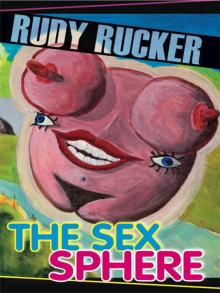 The Sex Sphere
The Sex Sphere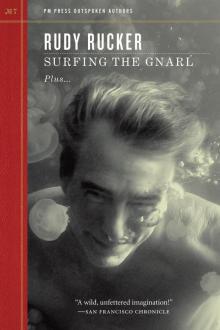 Surfing the Gnarl
Surfing the Gnarl Software
Software Mathematicians in Love
Mathematicians in Love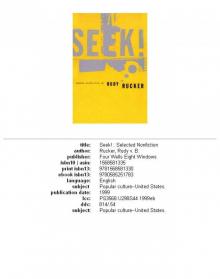 Seek!: Selected Nonfiction
Seek!: Selected Nonfiction The Secret of Life
The Secret of Life The Hacker and the Ants
The Hacker and the Ants Postsingular
Postsingular Spaceland
Spaceland Transreal Cyberpunk
Transreal Cyberpunk Sex Sphere
Sex Sphere Spacetime Donuts
Spacetime Donuts Freeware
Freeware The Ware Tetralogy
The Ware Tetralogy Frek and the Elixir
Frek and the Elixir Junk DNA
Junk DNA White Light (Axoplasm Books)
White Light (Axoplasm Books) Nested Scrolls
Nested Scrolls Inside Out
Inside Out Where the Lost Things Are
Where the Lost Things Are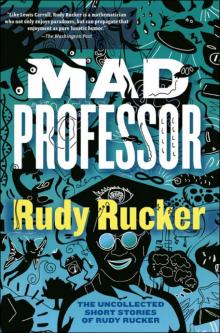 Mad Professor
Mad Professor As Above, So Below
As Above, So Below Realware
Realware Jim and the Flims
Jim and the Flims Master of Space and Time
Master of Space and Time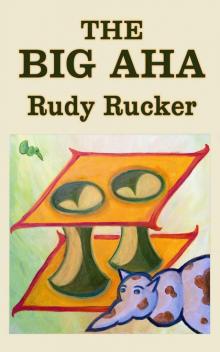 The Big Aha
The Big Aha Hylozoic
Hylozoic